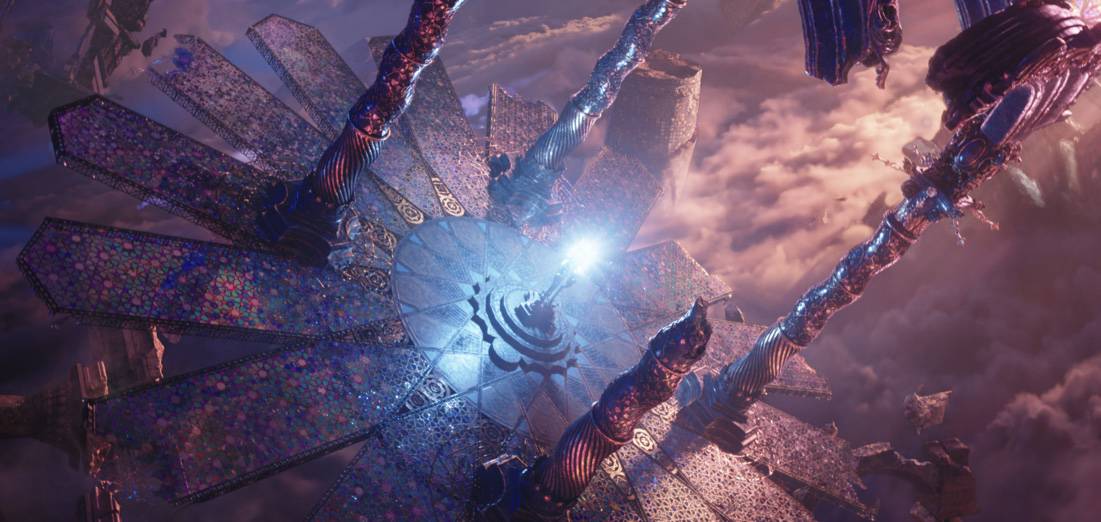When I saw “Doctor Strange in the Multiverse of Madness” (DSMM), I was completely taken by the religious symbolism and imagery used in the fim. The placement of certain symbols and their use conveyed a meaning that I can’t believe the screenwriters nor director intended. The statements they make are just too strong. I posit that Michael Waldron, screenwriter of DSMM, in making a beautiful piece of art, has unwittingly allowed an inherent Pattern of the world to emerge.
The whole idea that a Pattern emerges from the world is a very ancient worldview. It intuits the meaning of events as the result of deeply embedded patterns in reality itself. Such systems of thought are present in the Daoist & Confucianist concept of “the way;” the Roman stoics saw patterns in the world called the “natural law;” and, generally speaking the Judao-Christian tradition calls this pattern in the world “Wisdom” or “Divine-Logos.” They all share this similar sense of looking to creation. That is, they direct their followers to look outside themselves to find instruction on how to navigate this incarnate world.
Consider this in contrast to the modern worldview driven by scientific inquiry with its exclusive focus on manipulating the material. In this view, there is no inherent pattern to the universe. Everything is just molecules crashing into each other and navigating the world means conforming it against its own tendencies. But this typically modern perspective is beginning to discover how the ancient worldview it once scoffed at as ignorant is filling the gaps scientific materialism cannot cover.
Some scientists, when they cannot explain phenomena by material means, have opted to call the gap in material explanation “emergence.” This concept originates in the modern sciences through quantum physics where matter emerges, or pops into existence, out of a quantum field. In cognitive science, emergence is used to explain how through a complex material system—poof—consciousness happens. I’m of the opinion that what scientists now call “emergence” is that which is called Pattern or the Way in the older and ancient traditions.
DSMM delivers a lot of what Marvel fans love in these movies: action, esoteric characters, and a visual smorgasbord to satisfy the appetite of the eyes. Rather than summarizing DSMM, I want to focus on the symbolism present in the film. I hope to provide a couple of examples of how emergence works and maybe even provide a window into what is recoverable from the ancient worldview that the modern world abandoned over two centuries ago.
At the beginning of DSMM, America Chaves, a young girl from a universe other than our own with the uncanny and unique ability to open a portal and travel between universes, and Dr. Strange (who we later learn to be a variant), seek the Book of Vishanti, a book of light/good magic. Dr. Strange needs the spells from this book to correct the damage that has been created in the Multiverse after seven extreme and inappropriate uses of magic (e.g. time travel in Avengers: End Game, and the multidimensional debacle from Spiderman: No Way Home). They find the book in what appears to be a broken down universe, one where the fabric of reality is literally torn. We learn that there is only one Book of Vishanti, and the space in which it resides is the space between universes. It is a nexus, where the multiple universes meet, the center of the multiverse.
The Book of Vishanti sits on a pedestal at the center of the Multiverse. The pedestal itself is on a raised platform, at the corners of which are the brass pillars of Bernini’s Baldacchino from Saint Peter’s Basilica in Rome. Behind that, floating in open space, is a rose window, maybe from Chartre Cathedral or one of the other gorgeous French houses of worship. As if the writers couldn’t get any more Catholic, when the book of Vishanti is removed from its pedestal, the back of it has the same stained glass sun burst of the Holy Spirit that sits above Bernini’s brass vessel for the Chair of St. Peter, again from Saint Peter’s Basilica.
The image is clear: the writers put the Trinity at the center of the whole Multiverse, the space where all roads of the universe meet. The Father is represented by the altar, the book is the word that is Christ, and the stained glass sun-burst is the Holy Spirit. The setting the writers established is precisely the divine revelation that the Holy Spirit, the Advocate, who through the Son consummates the marriage of humanity and divinity on the wedding bed of the sacrificial altar signified by Bernini’s elegant four-post baldacchino.
My hope is the writers had no clue what they were doing because this would be a perfect example of “emergence.” Emergence is the revelation of meaning that is made known or made incarnate by the activity of human beings in participation with the activities of the universe. Because the universe is patterned (i.e. it has inherent meaning), certain facets of the pattern will emerge in an almost predictable fashion.
One of these emergent patterns of reality is that all human worship is ultimately directed towards the One True God. A bold statement, I know, but as I learned recently in one of the traditions of Indian Buddhism, among the many gods there is one that has a special status as the creator of all things. Even among the Mexica (or Aztecs, in modern language), Quetzalcoatl is a feathered serpent who dominates both the earth and sky. He represents a totality of existence. Our God, the God of Abraham, Issac and Jacob, is revealed by many names and by many forms, but His purest name that makes the divine identity most comprehensible to our human minds is the tetragrammaton: he is who is, the very essence of ‘to be’.
Of course, if the pattern claimed in the Christian tradition is to be completed, Christ must die. The Christian version of this story would have some kind of resurrection: a renewal and uplifting, brighter future; but, we are in a different story now. There is a modern, post-Chrisitan, deconstructionist dictatorship of relativism1 that dominates this epoch’s ethos. So, when the Scarlet Witch burns and destroys the Book of Vishanti the characters and plot move on without an afterthought. There’s no resurrection—truly a multiverse of madness.
The movie makes another interesting symbolic statement about the nature of good and evil. We learned that the Book of Vishanti, the good book, only has one iteration in the whole multiverse. It is one. However, the book of dark magic, the Darkhold (the book Scarlet Witch uses in order to travel the multiverse as an astral-projection that can take possession of versions of herself in alternate universes) has a version of itself in every universe. At the end of the film, when Wanda repossesses herself over the Scarlet Witch, she uses the Darkhold to connect with every iteration of it in the universe and destroys them all simultaneously.
There are two interesting things to say about this. The first is that in the emergent pattern, the good is one (complete, whole) and evil is many (as the Gerasene Demoniac said, “we are legion”). G.K. Chesterton in his book Orthodoxy states, “there are an infinity of angles at which one falls, only one at which one stands.” The second thing is the symbolic elimination of good and evil. Both are destroyed. Evil, from a Christian point of view, is not really a thing that exists. Rather, evil is the corruption of the good. It is parasitic of the good without which it ceases to exist entirely. While it seems like a liberation, the destruction of good and evil is a kind of enslavement to our own egos. But this is another topic to discuss altogether.
The materialistic worldview that has resulted from the absolute domination of the physical sciences has ushered in a world without Christ. This is not a judgment against the physical sciences, they are good when they serve their function in the pattern of reality. But when they are used by our fallen and limited capacity to reason, our minds dominate only to enslave itself to the material world, we lose the sense of good and evil, and therefore usher in a world without the hope of an afterlife.
Emergence helps us understand our concrete reality. We can read the wisdom present in the world. We are called to listen to reality, reconnecting ourselves to our bodies and our world, in order to recognize that reality has something to say back to us. We are not alone in this world, God is speaking to us through all that is, we only need to listen to His voice and read the word of Wisdom in the pattern of existence.


